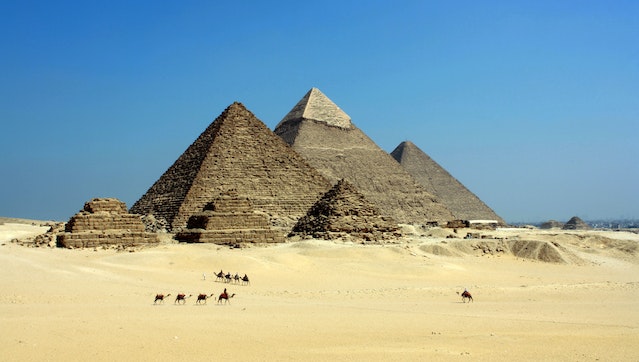
How was the Great Pyramid at Giza built? There are several theories, but no one knows for definite.
The Great Pyramid of Giza is the largest of the three pyramids in Giza and it was the first to be built. It was the oldest of the original seven wonders of the world and the only one that still exists. It was built by the pharaoh Khufu in approximately the 26th century BC and took about 27 years to build. The construction has been attributed to other pharaohs, but when the Relieving Chambers above the King’s Chamber were opened in 1837, they graffiti by the workers that had built the pyramids was discovered and they referenced Khufu more than 12 times. The dating is extremely difficult because the only records for the length of Khufu’s reign come from contemporary sources and there aren’t many of them. Radiocarbon dating was performed on the mortar of the pyramid, but this gave an age of between 8271-2604 BC. That discrepancy if probably because the wood used in the mortar came from trees of different ages.
The Great Pyramid is 146.6 meters tall. It was the tallest building in the world from its construction until the building of Lincoln Cathedral in 1311. It contains roughly 2.3 million blocks. When it was built, it was covered with smooth, white limestone, but that has all been removed. A lot of it could have been knocked off in earthquakes, but the rest was probably stolen for use in other buildings. The blocks for the pyramid were quarried in Giza, not far from the pyramid, in an area called Central Field. The limestone came from Tura, which is 10 km away. They were transported by boat. There are several giant granite stones used as the roofs of some of the rooms and they came from Aswan, about 900 km away.
So, how was the pyramid built? Well, it wasn’t built using slave labor, as the Greeks and many other people had thought. The graffiti found in the Relieving Chamber was only one example of graffiti found at the site. All of the graffiti appears to show that the workers were not slaves and they were divided into units of 40 men. The workers were probably paid, or working off a tax debt. There is a theory that these workers were mostly farmers who worked on the pyramids during the farming off season.
There were two steps to building the pyramid. The first was cutting and transporting the blocks. A set of the tools they used to cut the boulders have been found at the quarry site in Giza. They had hardened copper chisels, wooden mallets, ropes, and stone tools. They cut grooves into the face of the rock, inserted wooden wedges, and then soaked the wedges with water. The wedges absorbed the water and expanded, breaking the stone. The stone masons then used the other tools to neaten the blocks up. In order to finish the pyramid in the 27 years historians believe it took to build the pyramid, they would have had to cut 250 blocks a day. Experiments have shown that this would have been possible with a workforce of 3,500 men. Then the blocks had to be transported to the pyramid. Most of the blocks were probably pulled on a sled. When the sand was wetted with water, the sled slid fairly easily. Archaeologists have also found evidence of a long disappeared tributary of the Nile that ran to the base of the pyramids.
So, how did they get the blocks onto the pyramid? (It wasn’t aliens!) All of the experts agree that ramps were used, but they disagree on what kind of ramp. A straight ramp looks simple, but it would have to be 1.5 km long and require a tremendous amount of stone to keep the gradient manageable. There is also only space to build a ramp that long on the south side of the pyramid and no archaeological evidence has been found. A spiral ramp is another possibility, but this would have hidden most of the pyramid and made it difficult to ensure it had straight edges. It would also have been hard to make a ramp wide enough for people bringing sleds down to pass teams dragging blocks up.
Another theory is an eternal ramp. As the pyramid was built, the blocks were moved up a ramp inside the pyramid. When they finished the pyramid, they slowly worked backwards, filling the tunnel in. Either that, or they left the tunnel open and there is a tunnel inside the pyramid. The problem with this theory is that it is very complex, and the blocks would need to be turned by 90 degrees at the corners to go up the next ramp. The evidence given for this is that there were cranes mounted on the corners of the pyramid, in specially built rooms. The proponents of this theory believe that they have found one of the rooms on the corner of the pyramid. The Ancient Egyptians certainly had cranes capable of lifting great weights. They had a crane called a shadoof.
It is possible that they used a combination of ramps up to a certain height and then just lifted the blocks the rest of the way. They could have used cranes to lift the blocks to the higher levels. There is another method where the block is lifted at alternate ends and wooden blocks are inserted to raise the block up bit by bit. There is no way of knowing how it was done and no records were left. Unless something explaining it is found one day, it will remain guesswork. However, there are only so many logical ways you can build a pyramid with the equipment they had available, and a combination of all of the theories seems likely. And this is what I learned today.
Sources
https://www.nationalgeographic.com/history/article/giza-pyramids
https://www.britannica.com/video/226777/did-enslaved-people-build-the-pyramids
https://www.si.edu/spotlight/ancient-egypt/pyramid
https://www.egypttoday.com/Article/4/119442/How-were-the-Great-Pyramids-of-Giza-built
https://www.history.com/news/ancient-egypt-pyramid-ramp-discovery
https://en.wikipedia.org/wiki/Khufu
https://en.wikipedia.org/wiki/Egyptian_pyramid_construction_techniques
https://en.wikipedia.org/wiki/Great_Pyramid_of_Giza
